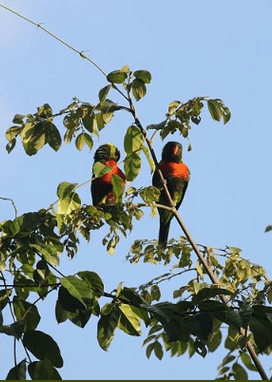Wild Mitchell’s Lorikeets (Trichoglossus forsteni mitchellii) are severely endangered in their native Indonesia. Concerted efforts are underway to save and study this subspecies.
The World Parrot Trust and Taman Safari III are carrying out a breeding-for-release program for Mitchell’s Lorikeet on Bali. Released individuals will be studied to determine how they’ve adapted to their environment, behaviour and survival rates. Uncovering the use of wild foods, roosting habits, feeding patterns, interactions with other wildlife and other ecological data will help WPT researchers create a roadmap for their recovery.
Tracking the released lorikeets’ progress and adaptation in the wild environment includes regularly scheduled surveys covering specific areas (area transects), data collection and recording, monitoring for trapping activities, surveys of known roosting sites, and closely watching occupied nest boxes. The data collected from these activities and analyzed will focus on population growth, habitat use, breeding success and the birds’ habituation to the release environment. Crucially, it will be an evaluatation of the overall success of the breeding program.
IUCN/CITES Status: Endangered / Appendix II (As conspecific with Trichoglossus forsteni)
Population: Fewer than 50 individuals.
Range: This lorikeet occurs in Indonesia on Bali, Nusa Penida, and Lombok islands.
Natural history: Mitchell’s Lorikeets are found in lowland and lower montane forests including secondary growth and plantations around forest edges. They feed mainly on nectar but will consume figs, and insects and can be found around man-made feeding stations. They are found in mixed flocks with other parrots in small noisy groups and are nomadic, searching for flowering trees.

